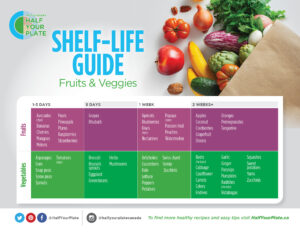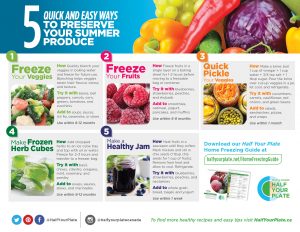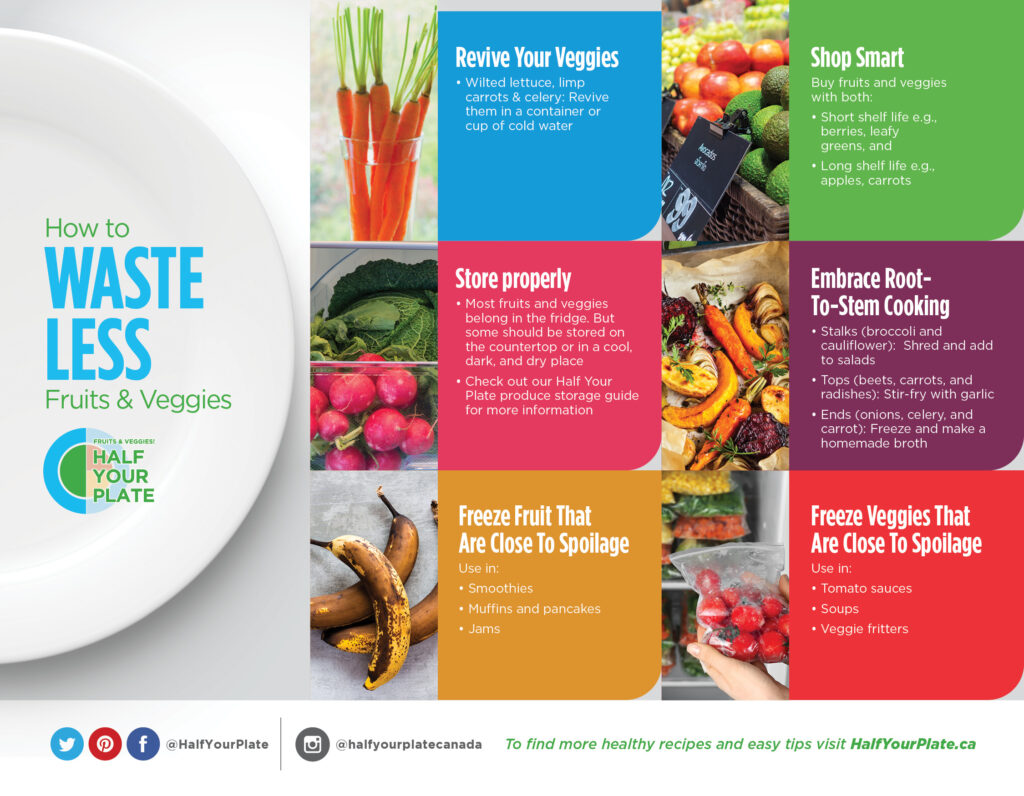Fruits and veggies are highly perishable and one of the top wasted foods in households. Find out how you can waste less fruits and veggies in your home to help you save money and the planet. Don’t forget to check our social channels for #WasteLessWednesday tips as well!
Before grocery shopping
- Check what fruits and veggies you have on hand at home. Look in your fridge, pantry, and freezer, before going to the grocery store. That way you won’t end with more than you need.
- Meal plan. When you have a plan for your food, less will end up as waste. Write down a few meal and snack ideas for the week to get started.

At the grocery store
- Become familiar with how to pick your produce. Look for firm cucumbers, melons that are heavy for their size, and corn with fresh green husks and uniform kernels. Discover more produce selection tips on our produce factsheets.
- Buy produce with both a short and long shelf-life. Berries and asparagus should be eaten within 1-3 days, while cabbage and apples can last 2 weeks or more. Check out our produce shelf-life guide for more information.
- Buy fruits like mangoes, pears, avocados, and kiwis, with varying degrees of ripeness. That way, you won’t end up with a bunch of ripe mangoes at the end of the week.
- Closely inspect your fruits and veggies. Avoid browning and bruised spots.
At home
- Store your fruits and veggies properly to keep your produce lasting longer.
- Most fruits and veggies are best stored in the fridge in the crisper drawer. But keep your fruits and veggies separate, as some fruits release ethylene gas which can spoil veggies.
- Produce that ripens should be stored on the countertop (i.e., avocadoes, kiwis, mangoes, pears, etc.). Once ripe, transfer them to the fridge. Tomatoes are the exception, whose taste and texture can change in the fridge.
- Store your garlic, onions, potatoes, squash, and sweet potatoes in a cool, dark, and dry place.
- Store asparagus and tender herbs, like cilantro and parsley, like flowers. Stand them up in a glass with 1-2 inches of water, cover with a produce bag, and place in the fridge.
- For more produce storage tips, check out our produce storage blog and produce storage guide:
While cooking
- Wash fruits and veggies just prior to eating or cooking. Washing ahead of time can make your produce go bad quicker.
- Try root-to-stem cooking. Broccoli stems, carrot tops, beet leaves, and herb stems are edible and delicious. Add to stir-fries, pesto sauces, or salads for flavour.
- Carrot ends, onion peels, celery stalk ends? Wash and freeze to make your own zero waste stock.

Freeze, when possible
- When produce is at its peak ripeness and you know you won’t be able to eat it before it goes bad, freeze it. Freezing works well for many fruits and veggies.
- Add chopped herbs to an ice cube tray and top with oil or water.
- Check out our produce home freezing guide or try these preparation techniques to preserve your produce:
When produce is near the end of its life
- Wilted lettuce, limp carrots, or limp celery? Bring them back to life by placing the leaves or stalks in a container or glass of cold water. Water will rehydrate your veggies, and they’ll be crisp in no time.
- Overripe fruit? Make banana bread, add to baked goods, smoothies, jams, or purée to make your own fruity salad dressing.
- Overripe veggies? Add to sauces, stews, or soups.
- If too far gone, compost your scraps to keep them out of landfills.
